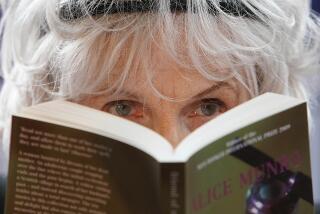Despite Illness, Author Pushed to the Finish Line
WASHINGTON — The little room on the second floor of the row house is organized to perfection, though this is something that an outsider would not understand. The water cooler, the glasses, the bowls and spoons--all sit only a small lift of the wrist away. Cereal boxes line the top of the desk, and milk is stored in a mini-refrigerator that doubles as a table for a fax machine and half a dozen bottles of pills. Scrapbooks are piled on the floor, within easy reach.
For nearly four years, Laura Hillenbrand sat in this room for up to eight hours a day and painstakingly, re-created the story of a Depression-era racehorse and the three eccentric men who made up his world. She almost never went out. Some days, she didn’t even go downstairs. Instead, she pored over old racing programs and newspaper clippings, did telephone interviews with 100-year-old track veterans, scoured EBay for racing memorabilia, begged strangers at faraway racetracks to copy documents and ship them to her house.
The book all that work produced, “Seabiscuit: An American Legend,” arrived in bookstores earlier this month, with a first printing of 50,000 copies and a movie adaptation in the early stages of production at Universal Pictures. Published by Random House, the book has been greeted by rave reviews and is predicted to be one of spring’s nonfiction sensations.
*
It is a story about horse racing, yes, but it is also a tale of the Depression and of a ragtag group of underdogs who enthralled a nation. Seabiscuit, as Hillenbrand writes, was such a phenomenon in his day that his name was mentioned in more newspaper articles in 1938 than Franklin Roosevelt’s or Hitler’s. His epic battle that year against War Admiral at Pimlico stands as perhaps the greatest horse race in history.
But he also was a “rough-hewn, undersized horse with a sad little tail and a knee that wouldn’t straighten all the way,” shepherded to his success by a half-blind jockey, an almost mute trainer and an owner who once made his living in bicycle repair.
Hillenbrand tells all their stories with incredible empathy. There is good reason for that. Just 33 years old, she can’t walk more than a block without becoming extremely tired. Her morning shower exhausts her. Vertigo causes the words on her computer screen to dip and weave as she types. Her live-in boyfriend, Borden Flanagan, has to help her with the smallest of needs.
Hillenbrand has chronic fatigue syndrome, a condition that can be so disabling--as it is in her case--that it leaves many of its victims cloistered from the outside world, lucky to be able to perform the most basic daily tasks. There is minimal treatment--or cure.
Random House editor Jon Karp “once said that Seabiscuit is a metaphor for my life, and he’s right,” Hillenbrand says. “The subjects that I’ve written about--the men and the horse--were radically different individuals, but the one thread that pulls through all of their lives and through the events that they lived through together is this struggle between overwhelming hardship and the will to overcome it.
“It’s a central theme in this book, and it is the central struggle of my life as well.”
It was March 20, 1987, when as a college student, Hillenbrand’s life changed. Six months into her relationship with Flanagan, she was driving with him back to campus from Washington when she ate some bad chicken and became violently ill. By the time she reached school, she was so overcome that her friends called the paramedics.
She suffered with the food poisoning for days, struggled to return to classes but seemed to be gradually losing energy. Two weeks later, she awoke and couldn’t sit up. Speaking was difficult. She called her parents, dropped out of school and went home to live.
*
She was bedridden for the next 10 months, fighting fevers that spiked and receded in six-hour intervals. Her mouth filled with sores, her lymph nodes swelled, she lost 20 pounds. Doctors suspected illnesses such as AIDS and multiple sclerosis but could never make a definitive diagnosis. One told her, dismissively, that her illness was psychosomatic. One told her she was--at 19--experiencing symptoms of adolescence. One accused her of being bulimic and stalked her on trips to the bathroom.
Even some of those closest to her had trouble understanding, or accepting, how ill Hillenbrand was. “I had difficulties with just about everyone taking it seriously at first,” she says. “I definitely had a lot of problems with people thinking that this is some sort of hypochondria or some sort of willful attempt to get attention.”
Finally, Hillenbrand received a diagnosis from John Bartlett, chief of the Division of Infectious Diseases at Johns Hopkins School of Medicine. Chronic fatigue syndrome, he said. Hillenbrand thought then--and does now--that it was a ridiculous name for the disease that has ravaged her life. Since then she has battled the often negative public perceptions of the illness.
“This illness is to fatigue what a nuclear bomb is to a match,” she says. “It’s an absurd mischaracterization.”
Affecting up to 1% of the population, chronic fatigue syndrome is recognized as a medical condition by the Centers for Disease Control and Prevention, which defines its symptoms as both severe chronic fatigue lasting more than six months and a combination of at least four other symptoms, including tender lymph nodes, muscle pain, joint swelling and headaches. Cases can vary widely in severity.
“I’ve seen cases where the amount of dysfunction that someone suffers with CFS is more severe than someone with rheumatoid arthritis, or lupus, or multiple sclerosis,” says Dan Clauw, an associate professor of medicine who directs the Chronic Pain and Fatigue Research Center at Georgetown University.
Hillenbrand is one of those cases. After going through an “up” period in the early ‘90s--she once was able to walk seven blocks and managed to fly to Seattle to meet Flanagan’s parents--she had a horrific slide in 1991. It started on the last day of August, on what she refers to as the darkest night of her life. Encouraged by her progress, Hillenbrand, Flanagan and friends took a trip to Saratoga Springs, N.Y., to the racetrack there. It’s an outing that she bitterly regrets.
“I was overreaching,” she says.
On the way back, Hillenbrand and Flanagan stopped at a friend’s house in New Jersey. That night she was hit with fever and chills and eventually went into shock. It was the beginning of a three-year decline so severe that there were times when she couldn’t roll over in bed by herself. There was a two-month period when she never went downstairs. Vertigo struck in 1993, and the one thing that still gave her comfort--reading and writing--became impossible.
After two years the vertigo, which still plagues her, began to loosen its relentless grip. Hillenbrand was able to return to writing. She had started writing freelance stories for horse racing magazines and trade publications in 1988, trying to find a purpose, she says, beyond simply “finding a way to endure the suffering.” When she got sick in 1991, she had been working steadily for Equus magazine, and losing the ability to write “was absolutely the worst thing.”
In 1995, Hillenbrand moved in with Flanagan, who had come to Washington after his college graduation and had been a constant part of her care.
“I am the most blessed person on Earth, I really am, because I have him,” she says. “He is compassionate, understanding. He shrugs off all of my flaws--and there’s a mountain of them--and loves me anyway. I’m still madly in love with him.
“And I’m happy. That’s an odd thing. The last four years have probably been the happiest in my life, even though I’ve been through a lot physically.”
*
All her life, Hillenbrand has been an avid reader of American Heritage. When she started freelancing, she fantasized about finding a story she could sell to the magazine.
Then she remembered Seabiscuit. As a child, she had read a young-adult book called “Come On Seabiscuit” and never forgot the tale. She began to research the topic and grew excited. Hillenbrand sent the magazine a query and was thrilled when the piece was accepted in 1997. It won horse racing’s Eclipse Award for magazine writing that year. In 1998, after a bidding war, she sold the book rights and the movie rights in the same week.
Hillenbrand requisitioned information from the Library of Congress, placed ads in the Daily Racing Form and Blood-Horse magazine, cold-called people who had worked at tracks some 50, 60, 70 years before. During one particularly strong spell, she and Flanagan made an all-day trip to the National Agricultural Library, which contains stores of records from racetracks. On good days, she stared at microfiche for hours.
Her meticulous research is evident in the book, which contains countless tiny details that bring Seabiscuit’s story to life. Even the supporting characters are well-rounded and colorful. One of Hillenbrand’s favorites is “Yummy, a round, toady-eyed, linty man, built low.”
Her descriptions of the races--particularly the famous meeting between Seabiscuit and War Admiral--are also wonderfully detailed. But the most compelling part of Hillenbrand’s narrative is the way she gets inside her characters’ hearts, including Seabiscuit’s.
“Humans aren’t the only creatures to seek mastery and rebel at being mastered,” Hillenbrand wrote. “The fire that had kept Seabiscuit frustrated and unruly now fueled a bounding will to win.”
More to Read
Sign up for our Book Club newsletter
Get the latest news, events and more from the Los Angeles Times Book Club, and help us get L.A. reading and talking.
You may occasionally receive promotional content from the Los Angeles Times.






